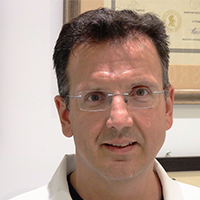Publications - Σε περιοδικά του SCI
Ανά είδος:
PURPOSE: To measure the rigidity coefficient of a large number of subjects at clinically encountered intraocular pressures (IOPs) and to examine the possible correlation of ocular rigidity with other factors, such as the age of the patients, ocular parameters (axial length and corneal thickness), and pathologic conditions affecting the eye.
METHODS: The pressure-volume relationship and the ocular rigidity coefficient (K) were determined in 79 eyes undergoing cataract surgery, by injecting 200 microL of saline solution (in steps of 4.5 microL) through the limbus into the anterior chamber, while continually monitoring the IOP with a transducer, up to the limit of 60 mm Hg. Data within an IOP range of 10 to 35 mm Hg were used to calculate the scleral rigidity coefficient. All measurements were taken at the same time of day, to eliminate any possible diurnal variation.
RESULTS: The mean ocular rigidity coefficient was 0.0126 mm Hg/microL (95% confidence interval [CI], 0.0112-0.0149). A statistically significant positive correlation between the rigidity coefficient and age of the patient was found (P = 0.02), whereas similar findings were not observed for the examined ocular parameters (axial length, P = 0.09; and corneal thickness, P = 0.12). No correlation was found for patients with diabetes mellitus (P = 0.39), age-related macular degeneration (P = 0.55), and hypertension (P = 0.45).
CONCLUSIONS: The present study provides quantitative data on the ocular rigidity coefficient based on measurements in a large series of living human eyes. A positive correlation between the ocular rigidity coefficient and the patient’s age was documented.
PURPOSE: To report the technique and small case series results of femtosecond laser-assisted sutureless anterior lamellar keratoplasty (FALK) for anterior corneal pathology.
DESIGN: Retrospective, noncomparative, interventional case series.
PARTICIPANTS: Twelve consecutive eyes from 12 patients with anterior corneal scarring.
INTERVENTION: Femtosecond laser-assisted sutureless anterior lamellar keratoplasty.
MAIN OUTCOME MEASURES: Measured parameters included femtosecond laser settings, technique, uncorrected visual acuity (UCVA), best-corrected visual acuity (BCVA), and complications.
RESULTS: Mean follow-up was 12.7 months (range, 6-24). No intraoperative complications were found. Uncorrected visual acuity (VA) improved in 7 eyes (58.3%) compared with preoperative VA. The mean difference between preoperative and postoperative UCVAs was a gain of 2.5 lines (range, unchanged-7 lines). Best-corrected VA was unchanged or improved in all eyes compared with preoperative levels. The mean difference between preoperative and postoperative BCVAs was a gain of 3.8 lines (range, unchanged-8 lines). In 2 eyes, adjuvant surgical procedures were performed (one treated with phototherapeutic keratectomy and the other with photorefractive keratectomy). Six patients (50%) developed dry eye after FALK, which improved during the follow-up period. No graft rejection, infection, or epithelial ingrowth was found in this series of patients.
CONCLUSIONS: Femtosecond laser-assisted sutureless anterior lamellar keratoplasty could improve UCVA and BCVA in patients with anterior corneal pathology.
PURPOSE: The aim of this study was to present the long-term results of corneal collagen cross-linking (CXL) in patients with keratoconus.
METHODS: In this prospective, interventional case series, patients with progressive keratoconus underwent CXL treatment according to the Dresden protocol. Visual, refractive, and topographic outcomes along with endothelial cell density were evaluated preoperatively and at 1, 2, 3, 4, and 5 years postoperatively.
RESULTS: Twenty-one patients (25 eyes) were enrolled. The mean follow-up was 43.7 ± 12.2 (range, 24-60) months. Logarithm of the minimum angle of resolution (logMAR) mean uncorrected visual acuity and the mean best spectacle-corrected visual acuity improved significantly from 0.92 ± 0.54 and 0.29 ± 0.21 preoperatively to 0.63 ± 0.41 (P = 0.010) and 0.18 ± 0.18 (P = 0.011), respectively, at the last follow-up. Mean steep and mean flat keratometry readings reduced significantly from 52.53 ± 6.95 diopters (D) and 48.11 ± 5.98 D preoperatively to 49.10 ± 4.50 D (P < 0.001) and 45.58 ± 3.81 D (P = 0.001), respectively, at the last follow-up. The mean endothelial cell density was 2708 ± 302 cells per square millimeter preoperatively and did not change significantly (P > 0.05) at any postoperative interval (2593 ± 258 cells/mm at the last follow-up; P = 0.149).
CONCLUSIONS: CXL seems to be effective and safe in halting progression of keratoconus over a long-term follow-up period up to 5 years postoperatively.
